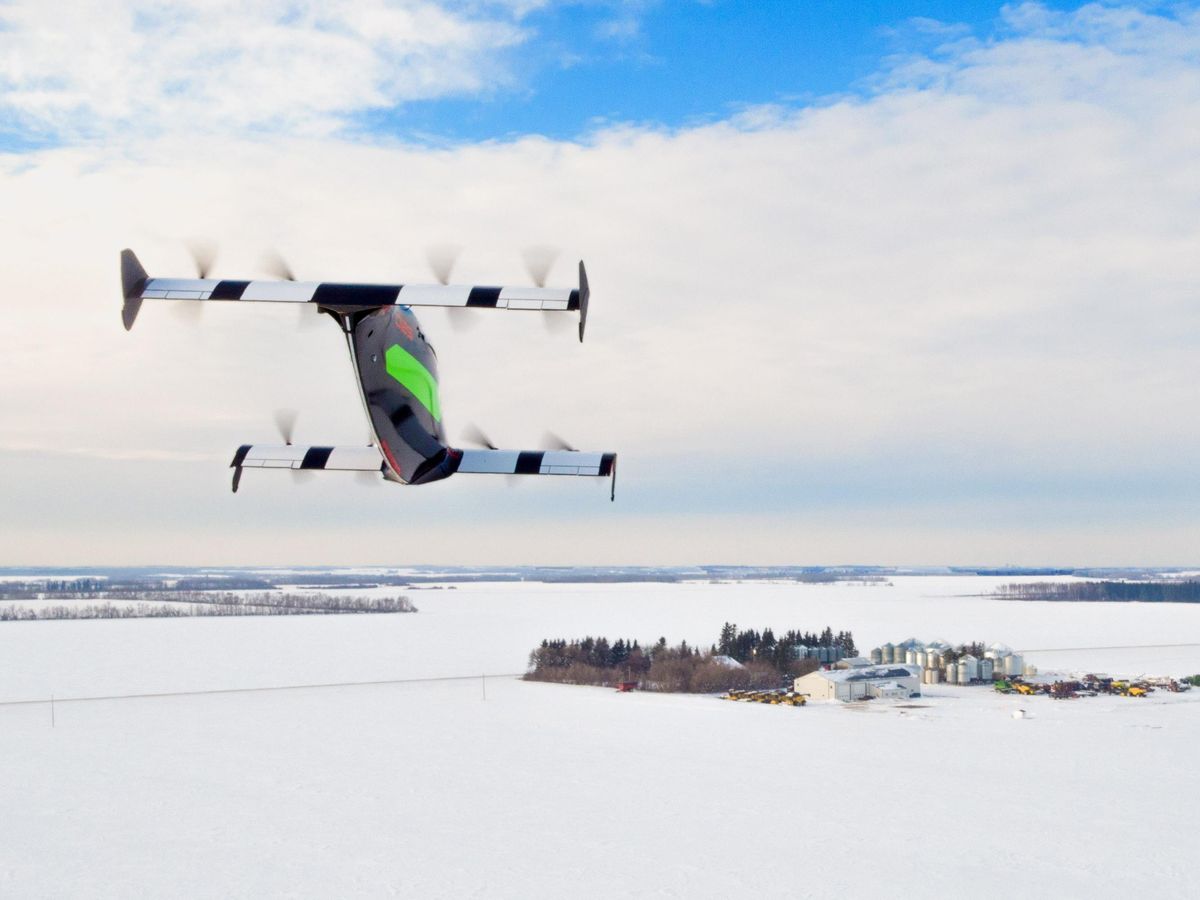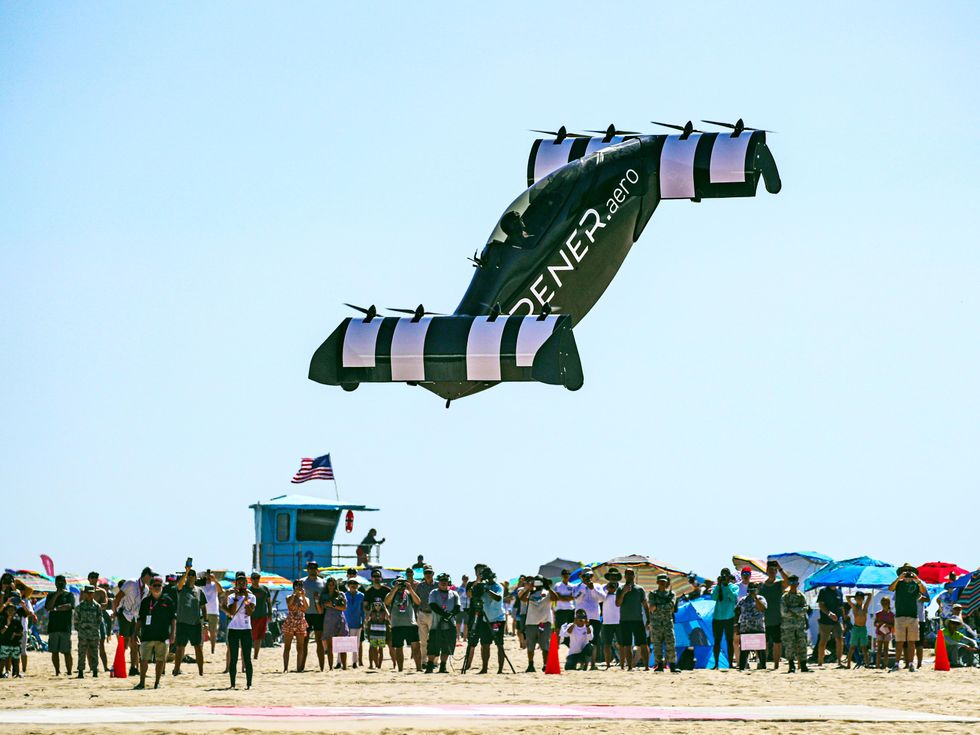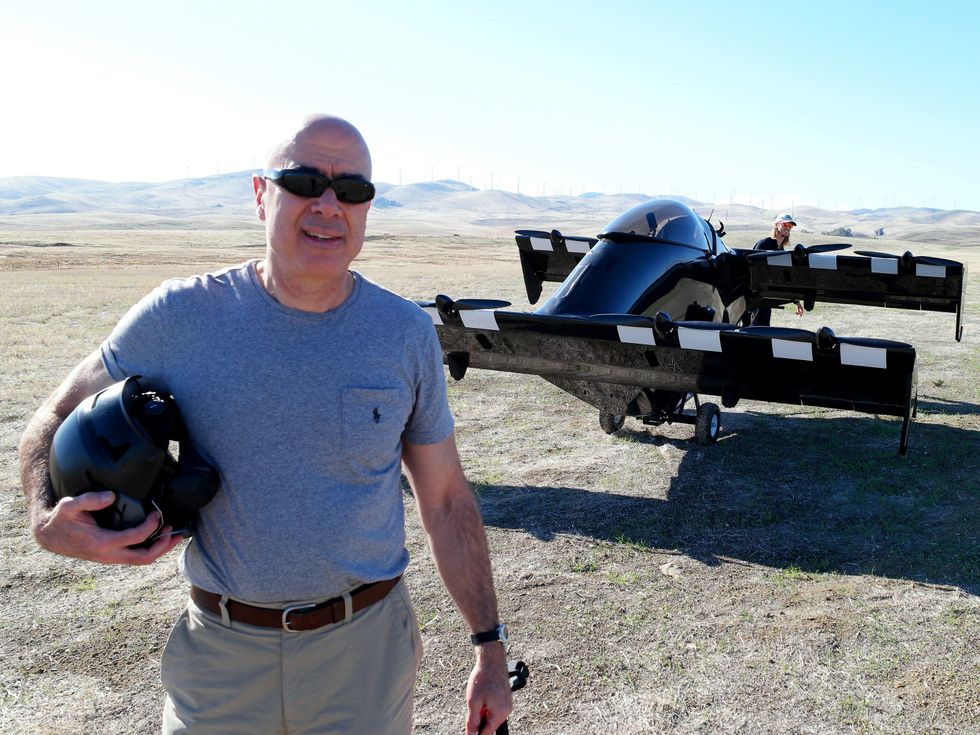Finally, an eVTOL You Can Buy (Soon)
You won’t need a pilot’s license to fly Opener’s BlackFly

A BlackFly eVTOL aircraft, from Opener, completed a test flight in Saskatchewan, Canada, in November 2019.
If electric vertical takeoff and landing aircraft do manage to revolutionize transportation, the date of 5 October 2011, may live on in aviation lore. That was the day when a retired mechanical engineer named Marcus Leng flew a home-built eVTOL across his front yard in Warkworth, Ont., Canada, startling his wife and several of his friends.
“So, take off, flew about 6 feet above the ground, pitched the aircraft towards my wife and the two couples that were there, who were behind automobiles for protection, and decided to do a skidding stop in front of them. Nobody had an idea that this was going to be happening,” recalls Leng.
This article is part of our special report Top Tech 2023.
But as he looked to set his craft down, he saw a wing starting to dig into his lawn. “Uh-oh, this is not good,” he thought. “The aircraft is going to spin out of control. But what instead happened was the propulsion systems revved up and down so rapidly that as the aircraft did that skidding turn, that wing corner just dragged along my lawn exactly in the direction I was holding the aircraft, and then came to a stable landing,” says Leng. At that point, he knew that such an aircraft was viable “because to have that sort of an interference in the aircraft and for the control systems to be able to control it was truly remarkable.”
It was the second time anyone, anywhere had ever flown an eVTOL aircraft.
Today, some 350 organizations in 48 countries are designing, building, or flying eVTOLs, according to the Vertical Flight Society. These companies are fueled by more than US $7 billion and perhaps as much as $10 billion in startup funding. And yet, 11 years after Leng’s flight, no eVTOLs have been delivered to customers or are being produced at commercial scale. None have even been certified by a civil aviation authority in the West, such as the U.S. Federal Aviation Administration or the European Union Aviation Safety Agency.
But 2023 looks to be a pivotal year for eVTOLs. Several well-funded startups are expected to reach important early milestones in the certification process. And the company Leng founded, Opener, could beat all of them by making its first deliveries—which would also be the first for any maker of an eVTOL.
Today, some 350 organizations in 48 countries are designing, building, or flying eVTOLs, according to the Vertical Flight Society.
As of late October, the company had built at its facility in Palo Alto, Calif., roughly 70 aircraft—considerably more than are needed for simple testing and evaluation. It had flown more than 30 of them. And late in 2022, the company had begun training a group of operators on a state-of-the-art virtual-reality simulator system.
Opener’s highly unusual, single-seat flier is intended for personal use rather than transporting passengers, which makes it almost unique. Opener intends to have its aircraft classified as an “ultralight,” enabling it to bypass the rigorous certification required for commercial-transport and other aircraft types. The certification issue looms as a major unknown over the entire eVTOL enterprise, at least in the United States, because, as the blog Jetlaw.com noted last August, “the FAA has no clear timeline or direction on when it will finalize a permanent certification process for eVTOL.”
Opener’s strategy is not without risks, either. For one, there’s no guarantee that the FAA will ultimately agree that Opener’s aircraft, called BlackFly, qualifies as an ultralight. And not everyone is happy with this approach. “My concern is, these companies that are saying they can be ultralights and start flying around in public are putting at risk a $10 billion [eVTOL] industry,” says Mark Moore, founder and chief executive of Whisper Aero in Crossville, Tenn. “Because if they crash, people won’t know the difference” between the ultralights and the passenger eVTOLs, he adds. “To me, that’s unacceptable.” Previously, Moore led a team at NASA that designed a personal-use eVTOL and then served as engineering director at Uber’s Elevate initiative.

Making eVTOLs personal
Opener’s aircraft is as singular as its business model. It’s a radically different kind of aircraft, and it sprang almost entirely from Leng’s fertile mind.
“As a kid,” he says, “I already envisioned what it would be like to have an aircraft that could seamlessly do a vertical takeoff, fly, and land again without any encumbrances whatsoever.” It was a vision that never left him, from a mechanical-engineering degree at the University of Toronto, management jobs in the aerospace industry, starting a company and making a pile of money by inventing a new kind of memory foam, and then retiring in 1996 at the age of 36.
The fundamental challenge to designing a vertical-takeoff aircraft is endowing it with both vertical lift and efficient forward cruising. Most eVTOL makers achieve this by physically tilting multiple large rotors from a vertical rotation axis, for takeoff, to a horizontal one, for cruising. But the mechanism for tilting the rotors must be extremely robust, and therefore it inevitably adds substantial complexity and weight. Such tilt-rotors also entail significant compromises and trade-offs in the size of the rotors and their placement relative to the wings.
Read about author Glenn Zorpette’s flight in a BlackFly here
Opener’s BlackFly ingeniously avoids having to make those trade-offs and compromises. It has two wings, one in front and one behind the pilot. Affixed to each wing are four motors and rotors—and these never change their orientation relative to the wings. Nor do the wings move relative to the fuselage. Instead, the entire aircraft rotates in the air to transition between vertical and horizontal flight.
To control the aircraft, the pilot moves a joystick, and those motions are instantly translated by redundant flight-control systems into commands that alter the relative thrust among the eight motor-propellers.
Visually, it’s an astounding aircraft, like something from a 1930s pulp sci-fi magazine. It’s also a triumph of engineering.
Leng says the journey started for him in 2008, when “I just serendipitously stumbled upon the fact that all the key technologies for making electric VTOL human flight practical were coming to a nexus.”
The journey that made Leng’s dream a reality kicked into high gear in 2014 when a chance meeting with investor Sebastian Thrun at an aviation conference led to Google cofounder Larry Page investing in Leng’s project.
Designing an eVTOL from first principles
Leng started in his basement in 2010, spending his own money on a mélange of home-built and commercially available components. The motors were commercial units that Leng modified himself, the motor controllers were German and off the shelf, the inertial-measurement unit was open source and based on an Arduino microcontroller. The batteries were modified model-aircraft lithium-polymer types.
“The main objective behind this was proof of concept,” he says.“I had to prove it to myself, because up until that point, they were just equations on a piece of paper. I had to get to the point where I knew that this could be practical.”
After his front-yard flight in 2011, there followed several years of refining and rebuilding all of the major components until they achieved the specifications Leng wanted. “Everything on BlackFly is from first principles,” he declares.
The motors started out generating 160 newtons (36 pounds) of static thrust. It was way too low. “I actually tried to purchase motors and motor controllers from companies that manufactured those, and I specifically asked them to customize those motors for me, by suggesting a number of changes,” he says. “I was told that, no, those changes won’t work.”
So he started designing his own brushless AC motors. “I did not want to design motors,” says Leng. “In the end, I was stunned at how much improvement we could make by just applying first principles to this motor design.”
Eleven years after Leng’s flight, no eVTOLs have been delivered to customers or are being produced at commercial scale.
To increase the power density, he had to address the tendency of a motor in an eVTOL to overheat at high thrust, especially during hover, when cooling airflow over the motor is minimal. He began by designing a system to force air through the motor. Then he began working on the rotor of the motor (not to be confused with the rotor wings that lift and propel the aircraft). This is the spinning part of a motor, which is typically a single piece of electrical steel. It’s an iron alloy with very high magnetic permeability.
By layering the steel of the rotor, Leng was able to greatly reduce its heat generation, because the thinner layers of steel limited the eddy currents in the steel that create heat. Less heat meant he could use higher-strength neodymium magnets, which would otherwise become demagnetized. Finally, he rearranged those magnets into a configuration called a Halbach array. In the end Leng’s motors were able to produce 609 newtons (137 lbs.) of thrust.
Overall, the 2-kilogram motors are capable of sustaining 20 kilowatts, for a power density of 10 kilowatts per kilogram, Leng says. It’s an extraordinary figure. One of the few motor manufacturers claiming a density in that range is H3X Technologies, which says its HPDM-250 clocks in at 12 kw/kg.
Advanced air mobility for everybody
The brain of the BlackFly consists of three independent flight controllers, which calculate the aircraft’s orientation and position, based on readings from the inertial-measurement units, GPS receivers, and magnetometers. They also use pitot tubes to measure airspeed. The flight controllers continually cross-check their outputs to make sure they agree. They also feed instructions, based on the operator’s movement of the joystick, to the eight motor controllers (one for each motor).
Equipped with these sophisticated flight controllers, the fly-by-wire BlackFly is similar in that regard to the hobbyist drones that rely on processors and clever algorithms to avoid the tricky manipulations of sticks, levers, and pedals required to fly a traditional fixed- or rotary-wing aircraft.
That sophisticated, real-time control will allow a far larger number of people to consider purchasing a BlackFly when it becomes available. In late November, Opener had not disclosed a likely purchase price, but in the past the company had suggested that BlackFly would cost as much as a luxury SUV. So who might buy it? CEO Ken Karklin points to several distinct groups of potential buyers who have little in common other than wealth.
There are early tech adopters and also people who are already aviators and are “passionate about the future of electric flight, who love the idea of being able to have their own personal vertical-takeoff-and-landing, low-maintenance, clean aircraft that they can fly in rural and uncongested areas,” Karklin says. “One of them is a business owner. He has a plant that’s a 22-mile drive but would only be a 14-mile flight, and he wants to install charging infrastructure on either end and wants to use it to commute every day. We love that.”
Others are less certain about how, or even whether, this market segment will establish itself. “When it comes to personal-use eVTOLs, we are really struggling to see the business case,” says Sergio Cecutta, founder and partner at SMG Consulting, where he studies eVTOLs among other high-tech transportation topics. “I’m not saying they won’t sell. It’s how many will they sell?” He notes that Opener is not the only eVTOL maker pursuing a path to success through the ultralight or some other specialized FAA category. As of early November, the list included Alauda Aeronautics, Air, Alef, Bellwether Industries, Icon Aircraft, Jetson, Lift Aircraft, andRyse Aero Technologies.
What makes Opener special? Both Karklin and Leng emphasize the value of all that surrounds the BlackFly aircraft. For example, there are virtual-reality-based simulators that they say enable them to fully train an operator in 10 to 15 hours. The aircraft themselves are heavily instrumented: “Every flight, literally, there’s over 1,000 parameters that are recorded, some of them at 1,000 hertz, some 100 Hz, 10 Hz, and 1 Hz,” says Leng. “All that information is stored on the aircraft and downloaded to our database at the end of the flight. When we go and make a software change, we can do what’s called regression testing by running that software using all the data from our previous flights. And we can compare the outputs against what the outputs were during any specific flight and can automatically confirm that the changes that we’ve made are without any issues. And we can also compare, to see if they make an improvement.”
Ed Lu, a former NASA astronaut and executive at Google, sits on Opener’s safety-review board. He says what impressed him most when he first met the BlackFly team was “the fact that they had based their entire development around testing. They had a wealth of flight data from flying this vehicle in a drone mode, an unmanned mode.” Having all that data was key. “They could make their decisions based not on analysis, but after real-world operations,” Lu says, adding that he is particularly impressed by Opener’s ability to manage all the flight data. “It allows them to keep track of every aircraft, what sensors are in which aircraft, which versions of code, all the way down to the flights, to what happened in each flight, to videos of what’s happening.” Lu thinks this will be a huge advantage once the aircraft is released into the “real” world.
Karklin declines to comment on whether an ultralight approval, which is governed by what the FAA designates “ Part 103,” might be an opening move toward an FAA type certification in the future. “This is step one for us, and we are going to be very, very focused on personal air vehicles for recreational and fun purposes for the foreseeable future,” he says. “But we’ve also got a working technology stack here and an aircraft architecture that has considerable utility beyond the realm of Part-103 [ultralight] aircraft, both for crewed and uncrewed applications.” Asked what his immediate goals are, Karklin responds without hesitating. “We will be the first eVTOL company, we believe, in serial production, with a small but steadily growing revenue and order book, and with a growing installed base of cloud-connected aircraft that with every flight push all the telemetry, all the flight behavior, all the component behavior, all the operator-behavior data representing all of this up to the cloud, to be ingested by our back office, and processed. And that provides us a lot of opportunity.”
This article appears in the January 2023 print issue as “Finally, an eVTOL You Can Buy Soonish.”

Top Tech 2023
Top Tech 2023: A Special Report
Preview exciting technical developments for the coming year.
Can This Company Dominate Green Hydrogen?
Fortescue will need more electricity-generating capacity than France.
Pathfinder 1 could herald a new era for zeppelins
A New Way to Speed Up Computing
Blue microLEDs bring optical fiber to the processor.
The Personal-Use eVTOL Is (Almost) Here
Opener’s BlackFly is a pulp-fiction fever dream with wings.
Baidu Will Make an Autonomous EV
Its partnership with Geely aims at full self-driving mode.
China Builds New Breeder Reactors
The power plants could also make weapons-grade plutonium.
Economics Drives a Ray-Gun Resurgence
Lasers should be cheap enough to use against drones.
A Cryptocurrency for the Masses or a Universal ID?
What Worldcoin’s killer app will be is not yet clear.
The company’s Condor chip will boast more than 1,000 qubits.
Vagus-nerve stimulation promises to help treat autoimmune disorders.
New satellites can connect directly to your phone.
The E.U.’s first exascale supercomputer will be built in Germany.
A dozen more tech milestones to watch for in 2023.
- This VC Is Betting Big on Flying Taxis and Scooters ›
- EVTOL Companies Are Worth Billions—Who Are the Key Players? ›
- Following the Money in the Air-Taxi Craze ›
- I Fly Opener’s BlackFly eVTOL - IEEE Spectrum ›



